Getting Started
Home Page
Section titled “Home Page”- Here you can create / open / rename / duplicate / delete any Scene.
- You can change the display of all Scenes from Grid to List.
- You can sort them alphabetically / most recently used / by creation date.
 Mapping Matter
Mapping Matter
Base Units of Measurement
Section titled “Base Units of Measurement”You first need to open a Scene. And then just navigate to :
TOP MENU > File > Project Settings…
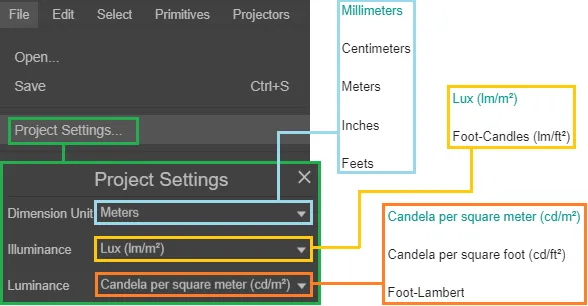 Base units
Base units
Import a 3D Asset
Section titled “Import a 3D Asset”We support .FBX(binary) very well, while .OBJ and .DAE work just fine. The maximum asset size is 100MB; you can load bigger assets but only locally.
Here’s an article about pre-import 3D Asset Optimization.
Import a 3D Asset into your Scene
Section titled “Import a 3D Asset into your Scene”TOP MENU : File > Import 3D mesh Objects
This will give you access to the 3D Assets Library.
Double-click on any file to import it in your Scene.
The first time you import an asset into you Scene, the Import Settings window will pop-up.
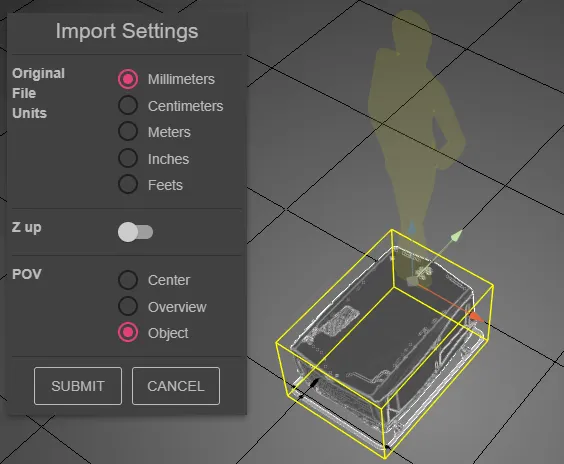 Import 3D yellow shadow
Import 3D yellow shadow
Original File Units = the unit of measurement your 3D mesh was exported in.
Z up = map the imported asset’s Y axis to the Scene’s Z axis. This basically rotate your asset 90° on the X axis. This option is available because some 3D softwares export meshes with the Y up.
POV = Point Of View = change the camera perspective.
Edit the Properties of an imported 3D mesh Object
Section titled “Edit the Properties of an imported 3D mesh Object”The editing parameters available will depend on how the the asset was exported (format, software, etc).
- Select your Object, go to its Properties.

- Next, navigate to the Reference panel.
- If you have a 3D asset built with different sub-Object meshes, you can edit each of them individually by enabling the Edit Reference mode.

You cannot move / rotate / delete any sub-Object mesh individually, you’ll have to import them already all set.
However, you can rename / hide them, and also edit their individual material.
If your mesh had UVs set pre-import, you can re-apply its Texture as a Base Map.
Move around the Viewport
Section titled “Move around the Viewport”The Viewport represents the whole visible area in which your Scene is displayed.
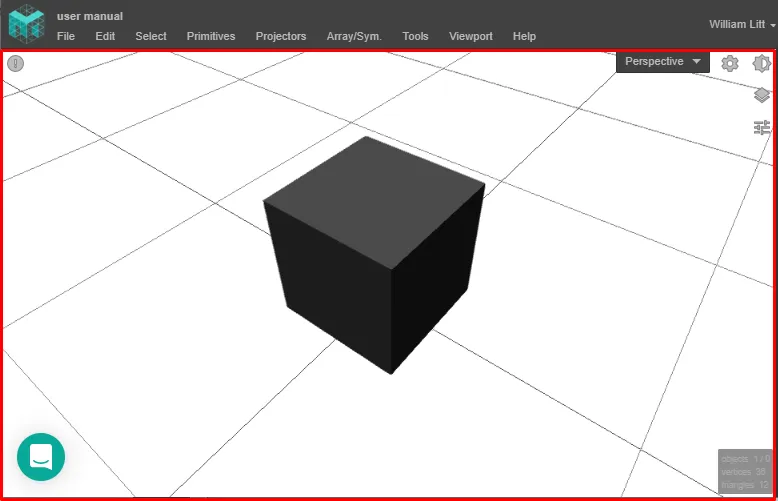 Viewport Overview
Viewport Overview
Hold left-click and drag to slide.
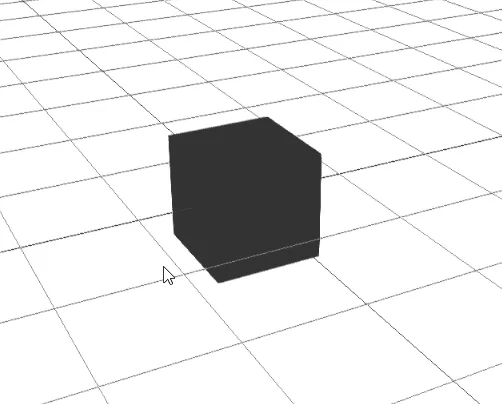 Pan
Pan
Hold right-click and drag to orbit your cursor. (On Mac: use two fingers while pressing on your touchpad.)
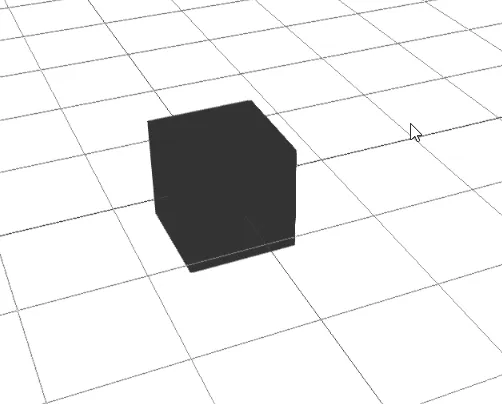 Orbit
Orbit
Zoom-in & out
Section titled “Zoom-in & out”- Using your scroll wheel.
- Using two fingers on your touchpad.
- Zoom-extend by…
- Double-clicking on the Object’s body in the Viewport itself.
- Or double-clicking on the Object’s name in the Scene Objects list.
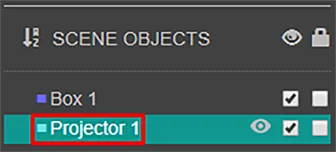
- Or select your Object, and go to TOP MENU > Viewport > Object Focus
Switch to another Point Of View (POV)
Section titled “Switch to another Point Of View (POV)”The Perspective dropdown menu allows to quickly look through our list of POVs.
 Move viewport perspective overview
Move viewport perspective overview
Camera from view = create a Camera from your current POV. This may come in handy as you may save a specific POV to come back to it later. All new Cameras will appear in the Scene Objects panel.
If needed, you can adjust very precisely the Position (and Target Point) of your Perspective POV (or any Orthographic Camera). Just go to Camera Settings.
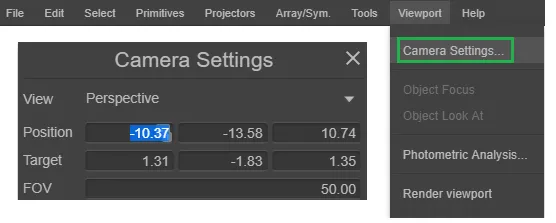 Viewport camera settings
Viewport camera settings
FOV = Zoom-in / out perfectly along the Target axis.
Primitives
Section titled “Primitives”Mapping Matter offers a quick & easy way to customize Parametric Objects. No need for advanced 3D skills.
Create a Primitive
Section titled “Create a Primitive”Each type of Primitive has its own parameters to play with (Width, Height, Depth, Radius, Segments, etc).
TOP MENU > Primitives
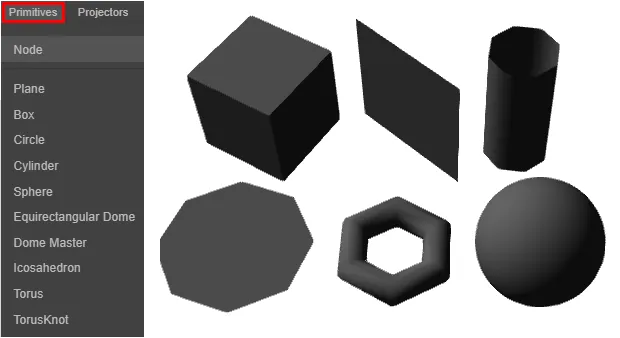 Primitives overview
Primitives overview
Customize a Primitive
Section titled “Customize a Primitive”Select it. Go to its Properties, and into the GEOMETRY section.
EXAMPLE 1: Build a Circular Wall with a Cylinder Primitive
Section titled “EXAMPLE 1: Build a Circular Wall with a Cylinder Primitive”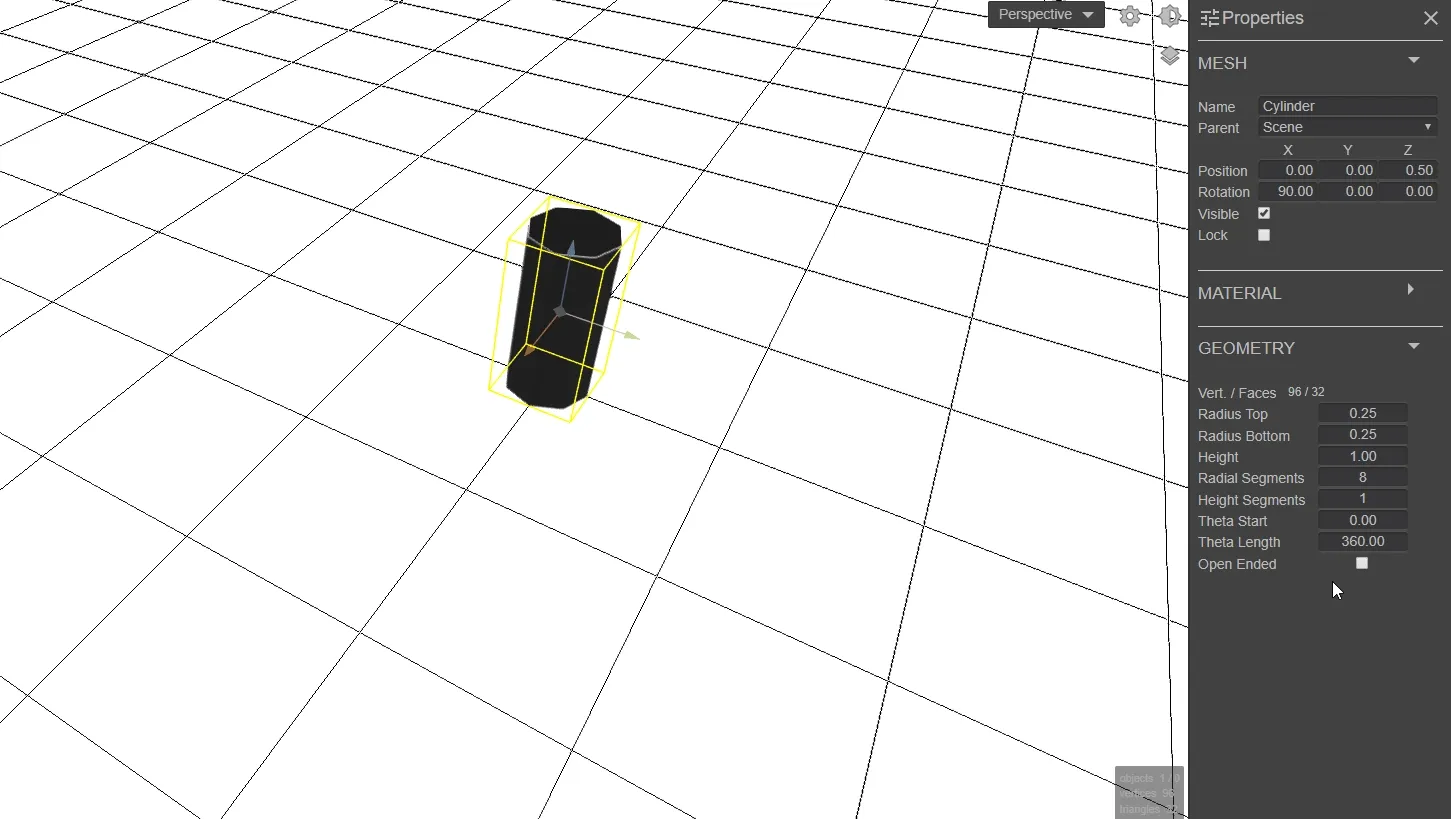 Primitive cyclinder circular wall
Primitive cyclinder circular wall
Segments = higher values increase the resolution of the Primitive.
Theta = the angle of definition.
EXAMPLE 2: Build a semi-Dome with a Sphere Primitive
Section titled “EXAMPLE 2: Build a semi-Dome with a Sphere Primitive” Primitive spheric half dome
Primitive spheric half dome
Phi & Theta = the angles of definition for a Sphere.
Select / Sort / Rename / Delete / Hide / Lock an Object
Section titled “Select / Sort / Rename / Delete / Hide / Lock an Object”Select
Section titled “Select”When you create an Object in your Scene, it will be listed in the Scene Objects panel.
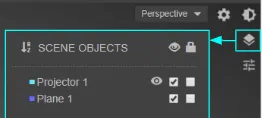 Scene objects list
Scene objects list
You can select an Object by clicking on its body in the Viewport, or through the Scene Objects list. Hold Ctrl to select many Objects.
Rename an Object
Section titled “Rename an Object”Select your Object in the Scene Objects panel.
Open the Properties panel, and edit its name in the textbox.
Delete an Object
Section titled “Delete an Object”Select it. And delete it…
by pressing Delete (PC) or Fn+Delete (Mac) on your keyboard,
or through TOP MENU > Edit > Delete
Imported 3D Asset’s sub-Objects cannot be deleted. However, you can hide them.
Hide / Show any Object of your Scene
Section titled “Hide / Show any Object of your Scene”You will find this option in the Scene Objects panel.
Tick the box to make it visible.

Lock the properties of any Object in your Scene
Section titled “Lock the properties of any Object in your Scene”Tick the box to lock it.
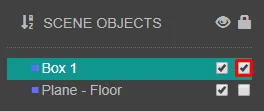 Scene object locked
Scene object locked
Move (or Duplicate) an Object
Section titled “Move (or Duplicate) an Object”An Object’s Position will be calculated from its Center Point, which appears as a diamond-shaped indicator.
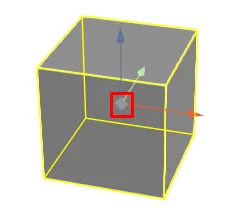 Centre point
Centre point
If you simply want to duplicate an Object, one way is to copy-paste it.
Select it.
Use Ctrl+C & Ctrl+V to have duplicated in any position.
Or go to TOP MENU > Edit > Clone to have it duplicated in the exact same position.
Using the Movement Gizmo in the Viewport
Section titled “Using the Movement Gizmo in the Viewport”Hold-click on any axis vector and drag your cursor.
 Move dup object axis
Move dup object axis
Or click once on any axis vector, type a World Position value in the input box, and press Enter.
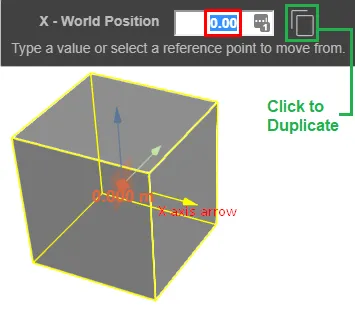 Move duplicate axis value
Move duplicate axis value
Using coordinates in the properties panel
Section titled “Using coordinates in the properties panel”Hold-click on the input box of any coordinate and drag your cursor.
 Move duplicate axis drag input box
Move duplicate axis drag input box
Or type-in a specific value and press Enter
Using two reference points
Section titled “Using two reference points”One to move from + one to move to.
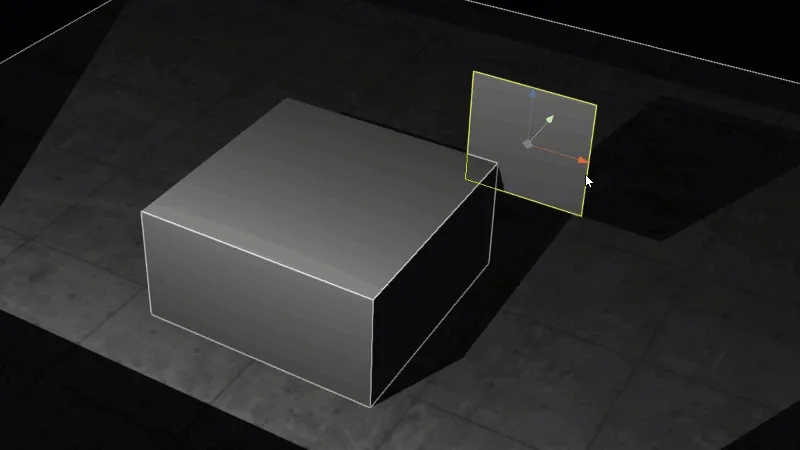 Move from to - select object
Move from to - select object
Select an Object, and click on its Center Point.
If you want to duplicate it, just click here.
 Move duplicate ref duplicate
Move duplicate ref duplicate
Click on a reference point to move from, and then another to move to.
Use the SNAP Tool to select a reference point more accurately in your Scene. This window will pop up automatically.
When neither Bounding Box or Vertex are enabled, the Red dot will appear at any intersection between the surface and your cursor.
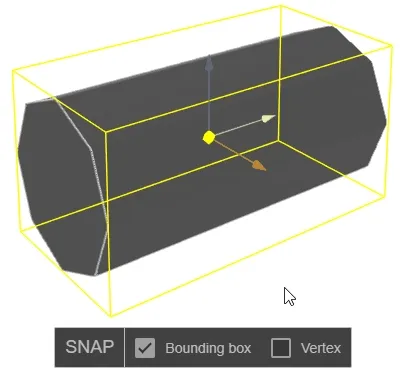 Scene object locked_
Scene object locked_
Move an Object A in orbit of an Object B
Section titled “Move an Object A in orbit of an Object B”Here’s a tutorial on how to set up a Pivot Point.
Rotate an Object
Section titled “Rotate an Object”Select an Object. (Or many, holding Ctrl)
Press R on your keyboard to see the Rotation Gizmo.
Hold-click on any axis curve, and drag your cursor to adjust.
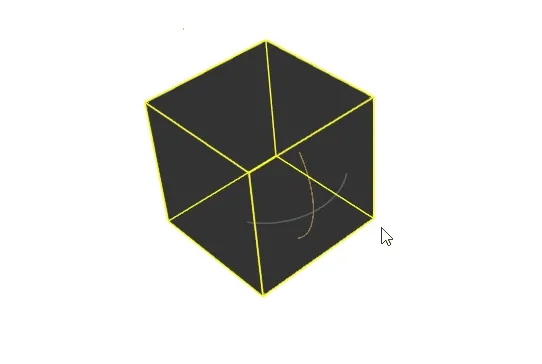 Rotate basic
Rotate basic
Or click once on any axis curve, and type in a specific angle rotation value.
 Rotate box”
Rotate box”
Press M to get back to the Movement Gizmo.
Material
Section titled “Material”The Material of an Object refers to the characteristics of its surface. This has an impact on its appearance, reflectivity, and texture mapping.
 Material overview
Material overview
Select your Object.
You can also select an individal (sub-Object) mesh from an Imported 3D Asset. Just select your Asset, click on Edit Reference, and select any mesh in the Scene Objects list.

Go to its Properties, in the MATERIAL section.
Apply Gain
Section titled “Apply Gain”Gain = The gain ratio represents how much light is reflected by any given surface, compared to the light reflected from a standard white (magnesium oxide) board. A ratio of 1.0 will reflect the same amount of light as that of white board. Whereas a gray board with a 0.5 rating would reflect only 50% of the Light falling on.
This has an incidence in the Photometric Analysis mode, on the Luminance values
Apply Color
Section titled “Apply Color”The brighter the selected color, the higher its reflectivity.
This has an incidence in the Photometric Analysis mode, on the Luminance values.
Apply Base Map
Section titled “Apply Base Map”The Base Map tool allows you to map (or “wrap”) an Image (or Video) onto the surface of a 3D mesh Object.
Go to Base Map and click in the framebox to open the Texture Library.
![]() Material base map open texture
Material base map open texture
To learn how to use the Texture Library, click here.
Adjust the placement of your Texture with the Map repeat and Map offset ratios.
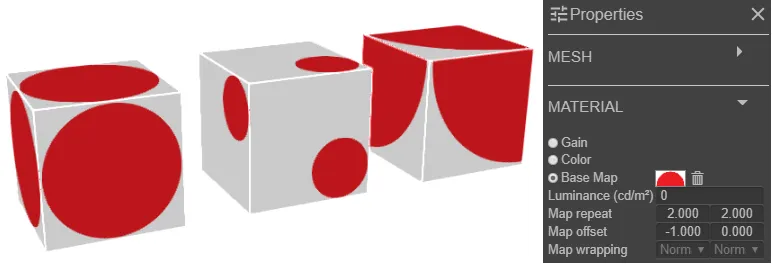 Material repeat offset
Material repeat offset
After you’ve selected an Image, you can remove it by clicking on the Trash icon.
![]()
![]() Material luminance_
Material luminance_
Apply a Projection Map (Projection Texture)
Section titled “Apply a Projection Map (Projection Texture)”The Projection Map tool allows you to map (or “wrap”) an Image (or Video) onto the surface of a 3D mesh Object.
The Base Map represents the intrinsic appearance of an Object.
Whereas the Projection Map represents a projected Texture onto the surface of an Object. By default, it won’t be visible in the Viewport. It will have to be “revealed”. Either by a Projector in Reverse Mapping mode, or using the Projection Texture tool.
Go to Projection Map and click in the framebox to open the Texture Library.
![]() Projection map framebox
Projection map framebox
To learn how to use the Texture Library, click here
After you’ve selected an Image, you can remove it by clicking on the Trash icon.
Use Side to make it transparent
Section titled “Use Side to make it transparent”Warning
First, make sure Global Material Override is disabled.
Go to Viewport Settings, and tick off the Double Side option.
Also note that it will only work with 1-face meshes (e.g. it won’t work with a double wall).
Select an Object. Go to its Properties, and to the MATERIAL section.
 Use Side to make it transparent_
Use Side to make it transparent_
Back = opacity prevents us to see through the surface.
Front = we can see through the surface.
Double = what appears on one side also appears on the other
Use Wireframe to make it transparent
Section titled “Use Wireframe to make it transparent”Wireframe =visual representation of a Mesh Object, only showing its vertices
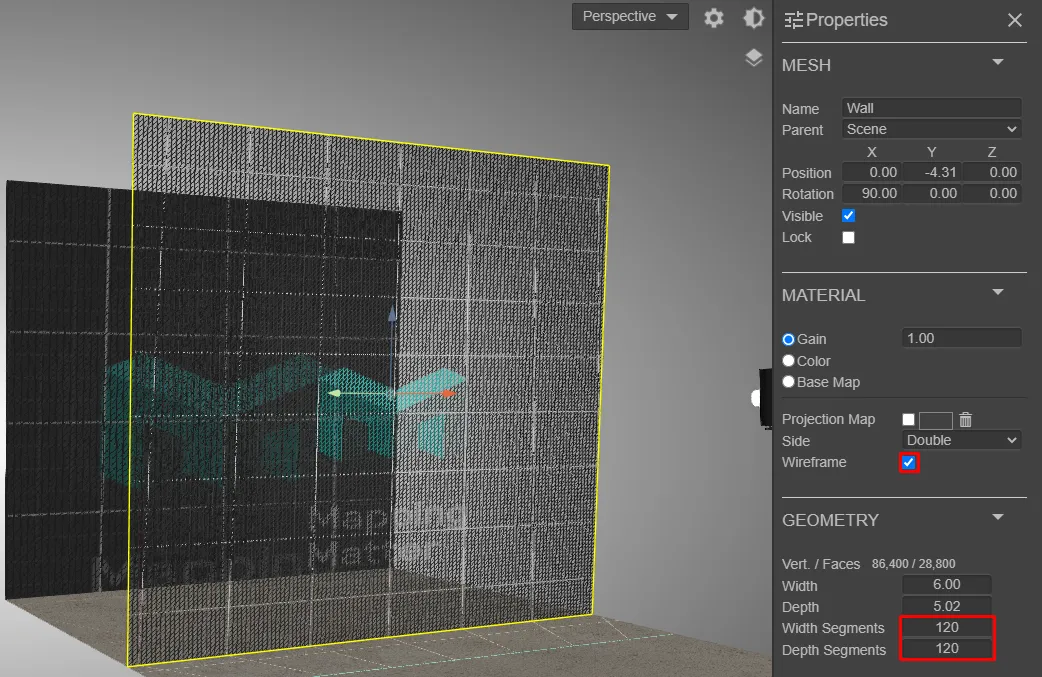 Material gauze
Material gauze
Parent Child Hierarchy
Section titled “Parent Child Hierarchy” Parent - child
Parent - child
The Position of an Object is calculated in function of the Center Point of its Parent Object.
By default, each new Object is the Child of the Scene itself.
To change the Hierarchy between Objects :
Select your Object, go to its Properties, and to the Parent dropdown menu.
Illustration
Section titled “Illustration”
Here both Sphere 1 and Box 1 have the coordinates (X=1, Y=0, Z=0). But Sphere 1 is positioned in function of its Parent the Scene (C), 1 meter away on the X axis. And Box 1 is 1 meter away from its Parent Sphere 1.
Arrays and Symmetries
Section titled “Arrays and Symmetries”These tools offer an easy, quick, and accurate way of creating large Object / Projector layouts in your Scene.
Definitions
Section titled “Definitions”Array = an immaterial Object which duplicates its Children into dummy Clones, either following a linear or a polar sequence.
Symmetry = an immaterial Object which duplicates its Children into dummy Clones, following a symmetric sequence.
Dummy = fake, visual only, not listed in Scene Objects, with no individual Propertie
Create a Linear Array
Section titled “Create a Linear Array” Parent - child hierarchy
Parent - child hierarchy
TOP MENU : Array/Sym. > Array
The Array will appear as an Object, Child of your Scene, at (0, 0, 0).
Select the Object you want to lay out.
In the Properties panel, make the Object a Child of the Array.
Customize the Linear Array parameters.
Number = the total amount of Objects in the Array = original + dummies
Separation = the distance between each Object in the Linear Array
Create a Polar Array
Section titled “Create a Polar Array” Parent - child hierarchy
Parent - child hierarchy
TOP MENU : Array/Sym. > Array Polar
The Array will appear as an Object, Child of your Scene, at (0, 0, 0).
Select the Object you want to lay out.
In the Properties panel, make the Object a Child of the Array.
Customize the Polar Array parameters.
Number = the total amount of Objects in the Array = original + dummies
Angle = the angle of distribution for all Objects in a Polar Array.
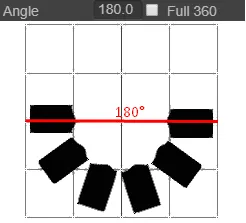 Array polar angle
Array polar angle
By default, a Full 360° angle distributes all Objects on a whole circle. But with a 180° input value, the distribution is limited on a 180° angle (half a circle). All Objects are automatically set equidistant to each other.
Create a Symmetry
Section titled “Create a Symmetry”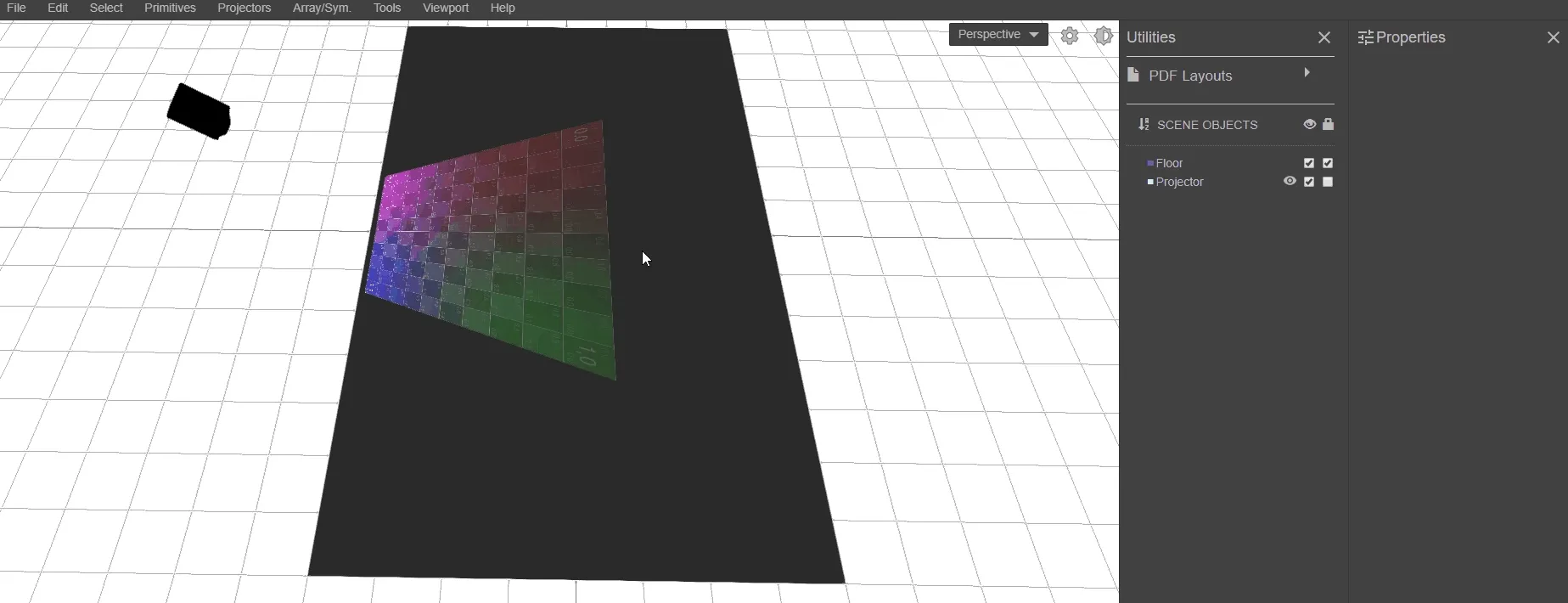 Array symmetry
Array symmetry
TOP MENU : Array/Sym. > Symmetry
The Symmetry will appear as an Object, Child of your Scene, at (0, 0, 0).
Select the Object you want to lay out.
In the Properties panel, make the Object a Child of the Symmetry.
Now our Object has a symmetric dummy along the X axis of our Symmetry.
The axis of symmetry is the Y axis. This is illustrated by a transparent yellow plane, which appears when the Symmetry Object is selected.
 Array symmetry plane reference
Array symmetry plane reference
All modifications to our Object will be replicated immediately to its dummy.
Convert your dummy Objects into regular Objects
Section titled “Convert your dummy Objects into regular Objects”This will allow you to make individual modifications to your ex-dummy Objects.
You’ll find each of them in the Scene Objects panel.
Select your original Object.
Go to the Properties panel.
In the Array (or Symmetry) section, hit the Bake command.
![]() Array symmetry bake
Array symmetry bake
Annotations and Dimensions
Section titled “Annotations and Dimensions”The Annotations tool allows you to create a bodyless Object holding Text.
While Dimensions allows you to create a bodyless Object measuring the distance between two given points the Scene.
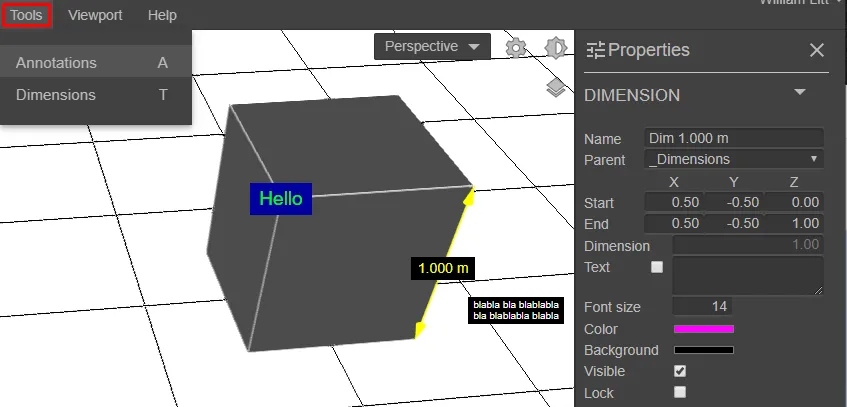
Create an Annotation or Dimension Object in your Scene
Section titled “Create an Annotation or Dimension Object in your Scene”TOP MENU > Tools
Select 1 or 2 Point(s) in your Scene.
1 Point only for Annotations. And 2 Points, from Start to End, for Dimensions.
Edit an Annotation or Dimension
Section titled “Edit an Annotation or Dimension”-
Select the Object, from the Scene or the Scene Objects panel.
-
Open the Object’s Properties panel.
 Annotations & dimensions properties
Annotations & dimensions properties